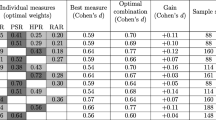Abstract
Either implicitly or explicitly, most workers in the last two decades have adopted the (imperialistic) view that conditioning is simply the learning of (cognitive) S-S relationships, and that (noncognitive) S-R factors are irrelevant. I shall remind us of some contrary evidence from human Pavlovian autonomic conditioning (HPAC), consideration of which may spoil our neat cognitive picture (representation?) of the world, but may also lead both to a better understanding of the conditioning phenomenon and to more genuinely useful applications of conditioning principles to behavioral (including psychophysiological) problems.
Similar content being viewed by others
References
Furedy, J.J. (1973). Some limits on the cognitive control of conditioned autonomic behavior.Psychophysiology, 10, 108–111.
Furedy, J.J. (1978). “Negative Results”: Abolish the name, but honour the same. In J.P. Sutcliffe (Ed.),Conceptual Analysis and Method in Psychology (pp. 169–180). Sydney: Sydney University Press.
Furedy, J.J. (1979). Teaching self-regulation of cardiac function through imaginational Pavlovian and biofeedback conditioning: Remember the response. In N. Birbaumer and H. Kimmel (Eds.),Biofeedback and Self-Regulation. (pp. 205–221). New Jersey: Erlbaum.
Furedy, J.J. & Poulos, C.X. (1976). Heart-rate decelerative Pavlovian conditioning with tilt as UCS: Towards behavioral control of cardiac dysfunction.Biological Psychology, 4, 93–106.
Furedy, J.J. & Poulos, C.X. (1977). Short-interval classical SCR conditioning and the stimulus-sequence-change-elicited OR: The case of the empirical red herring.Psychophysiology, 14, 351–359.
Furedy, J.J. & Riley, D. M. (1987). Human Pavlovian autonomic conditioning and the cognitive paradigm. In G. Davey (Ed.),Cognitive Processes and Pavlovian Conditioning in Humans (pp. 1–25). New York: Wiley.
Furedy, J.J. & Schiffman, K. (1971). Test of the propriety of the traditional discriminative control procedure in Pavlovian electrodermal and plethysmographic conditioning.Journal of Experimental Psychology, 91, 161–164.
Furedy, J.J. & Schiffman, K. (1973). Concurrent measurement of autonomic and cognitive processes in a test of the traditional discriminative control procedure for Pavlovian electrodermal conditioning.Journal of Experimental Psychology, 100, 210–217.
Öhman, A., Fredrikson, M., Hugdahl, K., & Rimmö, P. (1976). The premise of equipotentiality in human classical conditioning: Conditioned electrodermal responses to potentially phobic stimuli.Journal of Experimental Psychology: General, 105, 313–337.
Rescorla, R.A. (1967). Pavlovian conditioning and its proper control procedures.Psychological Review, 74, 71–80.
Rescorla, R. A. (1969). Pavlovian conditioned inhibition.Psychological Bulletin, 72, 77–94.
Rescorla, R.A. (1988). Pavlovian conditioning: It’s not what you think it is.American Psychologist, 43, 151–160.
Schiffman, K., & Furedy, J.J. (1972). Failures of contingency and cognitive factors to affect long-interval differential Pavlovian autonomic conditioning.Journal of Experimental Psychology, 96, 215–218.
Schiffmann, K., & Furedy, J.J. (1977). The effect of CS-US contingency variation on GSR and on subjective CS/US relational awareness.Memory and Cognition, 5, 273–277.
Segal, E. M., & Lachman, R. (1972). Complex behavior or higher mental process: Is there a paradigm shift?American Psychologist, 27, 45–55.
Siddle, D.T., & Remington, R. (1978). Comment on Furedy and Poulos (1977).Psychophysiology, 15, 609–10.
Stewart, M., Stern, J.A., Winokur, G., & Fredman, S. (1961). An analysis of GSR conditioning.Psychological Review, 68, 60–67.
Author information
Authors and Affiliations
Rights and permissions
About this article
Cite this article
Furedy, J.J. Some recalcitrant views on the role of noncognitive S-R factors in human pavlovian autonomic conditioning. Integrative Physiological and Behavioral Science 26, 21–25 (1991). https://doi.org/10.1007/BF02690974
Issue Date:
DOI: https://doi.org/10.1007/BF02690974




